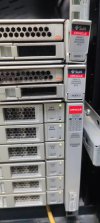As the title suggests, I have installed Proxmox ve v8.1 on my server and encountered an issue while configuring Ceph. When creating OSD, there will be the following error message. I checked the disk and found that LVM2_ The member has been successfully created, but the OSD creation failed. After searching for the logs, it was found that the corresponding vg volume group could not be found when the command "Volume group" ceph-3624de09-6d03-4264-b5c6-810a7ca11fdc "successfully created was executed. It seems that PVE cannot find the volume group. Both node servers in the current disk cabinet can access the same hard drive simultaneously. Due to the device being EOL and not having a valid service subscription, I am unable to obtain support from Oracle and cannot determine the specific reason.
Current hardware environment:
Oracle ODA x5-2+disk storage enclosure (HBA connected to two nodes)
CPU: E5-2699V3 * 2 X2
Mem: 256gb X2
Current hardware environment:
Oracle ODA x5-2+disk storage enclosure (HBA connected to two nodes)
CPU: E5-2699V3 * 2 X2
Mem: 256gb X2
create OSD on /dev/sdy (bluestore)
wiping block device /dev/sdy
200+0 records in
200+0 records out
209715200 bytes (210 MB, 200 MiB) copied, 0.509536 s, 412 MB/s
Running command: /bin/ceph-authtool --gen-print-key
Running command: /bin/ceph --cluster ceph --name client.bootstrap-osd --keyring /var/lib/ceph/bootstrap-osd/ceph.keyring -i - osd new 4a55bbc6-5e30-4e4d-8a8d-3a3985eaf6cc
Running command: vgcreate --force --yes ceph-3624de09-6d03-4264-b5c6-810a7ca11fdc /dev/sdy
stdout: Physical volume "/dev/sdy" successfully created.
stdout: Volume group "ceph-3624de09-6d03-4264-b5c6-810a7ca11fdc" successfully created
--> Was unable to complete a new OSD, will rollback changes
Running command: /bin/ceph --cluster ceph --name client.bootstrap-osd --keyring /var/lib/ceph/bootstrap-osd/ceph.keyring osd purge-new osd.0 --yes-i-really-mean-it
stderr: purged osd.0
--> RuntimeError: Unable to find any LV for zapping OSD: 0
TASK ERROR: command 'ceph-volume lvm create --data /dev/sdy' failed: exit code 1



